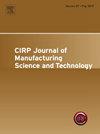Optimization of clamping conditions in thin-walled part machining to minimize forced vibrations, Part I: Model for the single tool –workpiece contact location
IF 5.4
2区 工程技术
Q2 ENGINEERING, MANUFACTURING
CIRP Journal of Manufacturing Science and Technology
Pub Date : 2025-06-12
DOI:10.1016/j.cirpj.2025.05.015
引用次数: 0
Abstract
Machining thin-walled, highly flexible parts is challenging due to excessive deflection, chatter, and forced vibrations, which can violate tolerance and surface finish requirements. These flexible parts are attached to the fixture or machine tool table using clamps. The location of the clamps and the clamping forces are usually selected intuitively in industry, although they affect the natural frequencies and magnitudes of the Frequency Response Functions (FRFs) of the part hence the deflections. This paper presents an algorithm to optimize the placement of clamps and the clamping forces to minimize static deflections and forced vibrations induced by milling forces at the fundamental tooth-passing frequency and its harmonics. The FRF at the tool-workpiece contact zone is calculated by analytically reducing the size of the full Finite Element (FE) model. The effect of clamping forces, and consequently the clamp stiffnesses, is considered in the model. It is shown that optimal clamping forces and clamp placements can lead to a reduction in both static deflections and forced vibrations. While this paper presents an optimal clamping condition model at a fixed tool path location, Part II extends the optimization to the entire tool path by considering the variation of workpiece dynamics caused by metal removal.
薄壁零件加工中夹紧条件的优化,以尽量减少强迫振动,第一部分:单工具-工件接触位置的模型
由于过度的偏转、颤振和强制振动,可能会违反公差和表面光洁度要求,因此加工薄壁、高柔性零件具有挑战性。这些柔性部件使用夹具连接到夹具或机床工作台。在工业中,夹具的位置和夹紧力通常是直观地选择的,尽管它们会影响零件的频率响应函数(frf)的固有频率和大小,因此会产生挠度。本文提出了一种优化夹具位置和夹紧力的算法,以最小化铣削力在基本过齿频率及其谐波上引起的静态挠度和强迫振动。在工具-工件接触区域的频响是通过解析减小整个有限元模型的尺寸来计算的。模型中考虑了夹紧力的影响,从而考虑了夹紧刚度。结果表明,最佳夹紧力和夹紧位置可以减少静态挠度和强迫振动。本文提出了固定刀路位置的最佳夹紧条件模型,第二部分通过考虑金属去除引起的工件动力学变化,将优化扩展到整个刀路。
本文章由计算机程序翻译,如有差异,请以英文原文为准。
求助全文
约1分钟内获得全文
求助全文
来源期刊

CIRP Journal of Manufacturing Science and Technology
Engineering-Industrial and Manufacturing Engineering
CiteScore
9.10
自引率
6.20%
发文量
166
审稿时长
63 days
期刊介绍:
The CIRP Journal of Manufacturing Science and Technology (CIRP-JMST) publishes fundamental papers on manufacturing processes, production equipment and automation, product design, manufacturing systems and production organisations up to the level of the production networks, including all the related technical, human and economic factors. Preference is given to contributions describing research results whose feasibility has been demonstrated either in a laboratory or in the industrial praxis. Case studies and review papers on specific issues in manufacturing science and technology are equally encouraged.
 求助内容:
求助内容: 应助结果提醒方式:
应助结果提醒方式:


